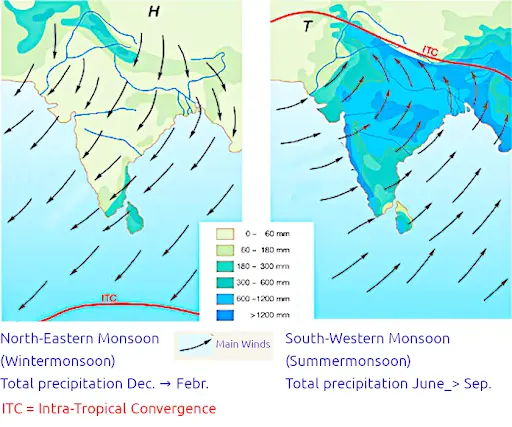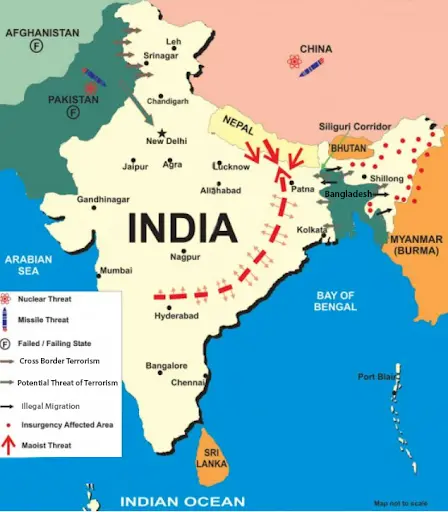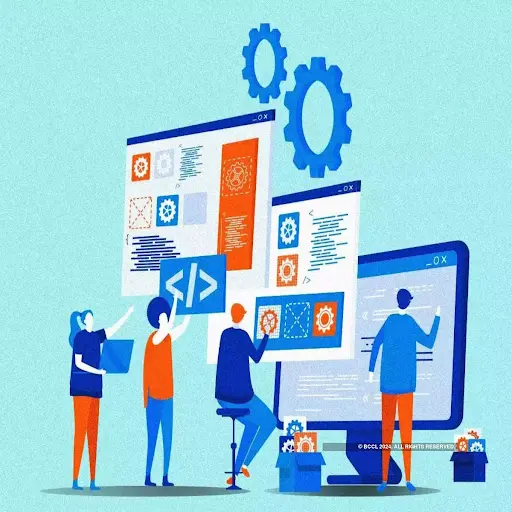Thursday, 20th June 2024
QUAD: Diplomacy and Cooperation in the Indo-Pacific
Why in the news ?
- The Quad, (Quadrilateral Security Dialogue), has evolved into a strategic alliance focused on security, diplomatic collaboration, and the provision of public goods among its members and throughout the Indo-Pacific region over the past two decades.

About the Quad:
- The Quad, comprising India, Japan, Australia, and the United States, has emerged as a significant diplomatic platform aimed at ensuring a free, open, and inclusive Indo-Pacific region.
- It focuses on upholding international law, maintaining freedom of navigation, and promoting democratic values within the region.
- The Quad countries collectively host 1.9 billion people (24% of the world’s population) and account for 35% of the world’s GDP and 18% of global trade.
Genesis and Evolution:
- The Quad was conceived in the early 2000s to leverage the converging interests of its member nations.
- Its inception responded to the growing need for a collaborative approach to address challenges in the Indo-Pacific, particularly those posed by natural disasters and regional security threats.
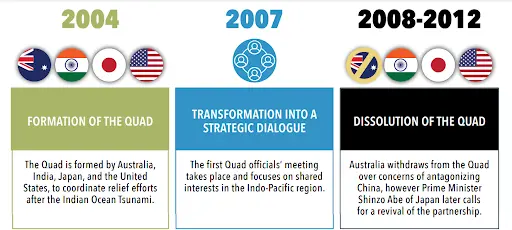

General timeline of events:
|
2004 |
December 26 |
Australia, India, Japan, and the United States form a coalition to coordinate aid and streamline assistance following the Indian Ocean Tsunami, which killed 228,000 people across 14 countries in the Indo-Pacific. |
|
2007 |
May 25 |
Quad senior officials meet for the first time on the sidelines of the ASEAN Regional Forum in Manila, the Philippines. |
|
August 22 |
Prime Minister of Japan, Shinzo Abe’s “Confluence of the Two Seas” speech provides a foundation for the Quad as an “open and transparent” network that “will allow people, goods, capital and knowledge to flow freely.” |
|
|
September 7 |
Australia, Japan, and Singapore participate in Exercise Malabar, previously a bilateral naval exercise between the United States and India, sparking protests from China. |
|
|
2008 |
February 5 |
Australia assures China that it will withdraw from the Quad. |
|
2012 |
December 27 |
Prime Minister Shinzo Abe calls for a “democratic security diamond” whereby “Australia, India, Japan, and the U.S. state of Hawaii form a diamond to safeguard the maritime commons stretching from the Indian Ocean region to the western Pacific.” |
|
2015 |
October 12 |
Japan became a permanent member of Exercise Malabar. |
|
2017 |
November 12 |
In the first senior-level meeting of the renewed Quad, officials from all four countries meet on the sidelines of the ASEAN Summit in Manila, the Philippines. |
|
2018 |
June 7 |
Quad senior officials meet for a second time on the margins of the ASEAN Senior Officials’ Meeting in Singapore. |
|
November 15 |
The third Quad Senior Officials’ Meeting occurs at the East Asia Summit in Singapore. |
|
|
2019 |
May 31 |
The Quad holds its foreign ministerial-level meeting on the sidelines of the United Nations General Assembly in New York City, the United States. |
|
2020 |
November 2 |
Australia rejoins Exercise Malabar. |
|
2021 |
March 12 |
The first Quad Leaders’ Summit is held virtually and the joint statement The Spirit of the Quad is released. |
|
September 24 |
The second Quad Leaders’ Summit is held in-person in Washington D.C., the United States. |
|
|
2022 |
March 4 |
The third Quad Leaders’ Summit is held virtually to discuss the conflict in Ukraine and its impact on the Indo-Pacific region. |
|
May 24 |
The fourth Quad Leaders’ Summit takes place in Tokyo, Japan as a standalone meeting. This is the second in-person Quad Leaders’ Summit. |
|
|
2023 |
March 3 |
The Quad Working Group on Counterterrorism is announced at the sixth Quad Foreign Ministers’ meeting in New Delhi, India. |
|
May 20 |
The fifth Quad Leaders’ Summit takes place in Hiroshima, Japan on the sidelines of the Group of Seven Summit. |
Quad Initiatives and Focus Areas:
- Quad Health Security Partnership:
- In 2021, they met virtually for the first time alongside three new partners — South Korea, Vietnam, and New Zealand, informally called the Quad-Plus.
- Established initiatives like the Quad Vaccine Partnership.
- Climate Working Group:
- Launched the Quad Climate Change Adaptation and Mitigation Package (Q-CHAMP) at the 2022 Quad Leaders’ Summit in Tokyo.
- Focus areas include climate-smart agriculture, carbon recycling, and subnational climate action knowledge sharing.
- Q-CHAMP builds on three pillars: climate ambition, clean energy, and adaptation and resilience.
- Emphasises the need for secure, resilient, and sustainable clean energy supply chains, reducing emissions from mining, production, and manufacturing.
- Critical and Emerging Technology (CET) Working Group:
- Addresses technologies like AI, quantum computing, autonomous systems, and biotechnologies.
- The Quad International Standards Cooperation Network enhances coordination and influence in international standards development.
- Promotes global technology markets, sets technical standards, and coordinates on 5G networks and horizon scanning.
- Space Working Group:
- Quad nations share Earth observation satellite data for monitoring climate change, improving disaster response, and ensuring sustainable use of oceans and marine resources.
- The global space economy was worth $546 billion in 2022, with commercial revenue accounting for 78% of the sector.
- Quad Infrastructure Coordination Group:
- Addresses the infrastructure financing gap due to rapid regional growth, focusing on transport, power, telecommunications, water supply, and sanitation.
- Despite $881 billion in annual infrastructure investment in the region, the figure drops to $195 billion excluding China’s investments.
- From 2015 to 2021, Quad countries provided over $48 billion in infrastructure financing to the Indo-Pacific.
- Quad Senior Cyber Group:
- Cybercrime resulted in $1 trillion in global economic losses in 2020.
- In 2022, all Quad countries were among the top 20 international cyber victims.
- Established the Quad Cybersecurity Partnership to address cyber threats, focusing on critical infrastructure protection, supply chain resilience, workforce development, and software security standards.
India and the Quad:
- Platform for Consultation: The Quad serves as a platform for India to engage with major powers on regional security and economic issues, aligning with its foreign policy objectives.
- Countering China's Influence: As a regional power, India uses the Quad to counter China's dominance in the Indian Ocean and to ensure security in the Indo-Pacific.
- Commitment to Regional Stability: India’s participation in the Quad reflects its dedication to regional stability and its role as a significant global player.
Challenges and Criticism:
- Emergence of AUKUS:
- AUKUS Formation: The creation of the Australia-UK-US (AUKUS) Indo-Pacific grouping has raised questions about the Quad’s future relevance.
- Focus Differences: AUKUS focuses on broader global social issues such as climate change, COVID-19 vaccines, and supply chain resilience, while the Quad addresses stronger strategic aspects.
- Free and Open Indo-Pacific:
- Rules-Based Order: The Quad emphasises a ‘free, open, rules-based order’ rooted in international law to counter threats in the Indo-Pacific region.
- Tensions with China: Tensions with China, particularly regarding unilateral actions in the South China Sea, drive the Quad's focus on maintaining a rules-based order.
- Connectivity and Infrastructure:
- Transparent Funding: The Quad aims to provide transparent infrastructure funding and joint connectivity projects to countries in the region.
- Debt-Trap Prevention: This initiative is designed to prevent countries from becoming ‘debt-trapped’ by other initiatives, such as China’s Belt and Road Initiative.
- Critical Technologies and Supply Chains:
- Working Group on Technologies: The Quad has established a working group on critical and emerging technologies to cooperate on international standards and innovation.
- Supply Chain Resilience: Ensuring resilient supply chains is a priority for the Quad, addressing potential vulnerabilities and promoting robust economic cooperation.
Way Forward:
- Collaborative efforts in combating climate change, enhancing pandemic response capabilities, and promoting sustainable development are essential for the region's well-being.
- Fostering deeper economic ties and technological partnerships will be crucial in shaping the future of Indo-Pacific diplomacy.
- Critics often highlight the absence of a formal charter or binding commitments among the member countries, questioning the group's cohesiveness and long-term vision.
- The Quad's perceived role in countering China's influence in the region. The group's strategies and actions are often scrutinised for their implications on regional dynamics and balance of power.
- The next decade will be pivotal for the Quad to solidify its role as a cornerstone of peace and stability in the Indo-Pacific.
- Continued adaptation, strategic cooperation, and addressing criticisms head-on will be key to ensuring the Quad's enduring impact and success.
|
UPSC Civil Services Examination Previous Year Question (PYQ) Mains Q:1 Quadrilateral Security Dialogue (Quad) is transforming itself into a trade bloc from a military alliance, in present times Discuss. (2020) |
Earth’s Inner Core Rotation Slowing Down
Why in the news ?
- Recently, new study has provided compelling evidence that the Earth’s solid inner core, composed of iron and nickel, began to slow down its rotation compared to the planet’s surface in 2010.
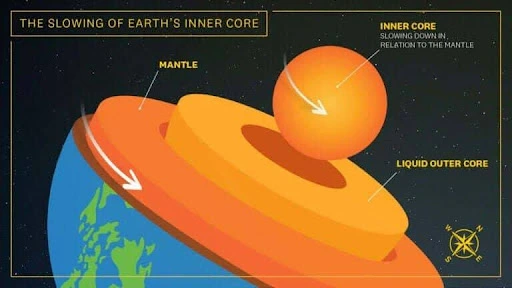
- Since the Earth’s core and most part of the Earth’s interior is physically inaccessible, researchers typically study it by analysing seismic waves generated by earthquakes recorded on seismograms.
Impacts:
- The process could potentially change the length of a day on Earth by fractions of a second.
- The inner core‘s spin is influenced by the magnetic field generated in the liquid outer core and gravitational effects within the Earth’s mantle.
- The inner core’s rotation generates Earth’s magnetic field and influences geological processes. Changes in its rotational speed could affect Earth’s magnetic properties and geomagnetic events.
- The recent study says that the inner core is reversing and backtracking relative to the surface, rotating slower than the mantle for the first time in about 40 years.
Connection to Climate Change and Earth’s Rotation:
- A separate study (Nature Journal) found that climate change-driven melting of ice in Greenland and Antarctica was affecting global timekeeping by slowing down Earth’s rotation.
- The liquid core was slowing down, causing the solid Earth to rotate faster to counterbalance the effect, resulting in fewer ‘leap seconds’ being needed to be added to the Coordinated Universal Time (UTC).
|
Coordinated Universal Time (UTC):
- UTC is the primary time standard by which the world regulates clocks and time. It is based on precise atomic clocks and is maintained by the International Bureau of Weights and Measures (BIPM).
- UTC is designed to approximate the mean solar time at 0° longitude (the prime meridian), which is the basis for civil time and time zones.
Leap Seconds:
- The Earth’s rotation is gradually slowing due to tidal forces from the Moon and Sun, as well as changes in Earth’s structure and climate. Consequently, the length of a day based on Earth’s rotation increasingly diverges from the day defined by atomic clocks.
- To account for this divergence and keep UTC in sync with the Earth’s rotation, leap seconds are added.
- A leap second is a one-second adjustment that is inserted as a “stop” second into UTC to keep it aligned with the Earth’s rotation. It is added on either June 30th or December 31st, as required.
Source: IE
CRISPR Cas9 Gene Therapy for Sickle Cell Disease
Why in the News?
- Recently, India is advancing towards the development of a CRISPR-Cas9-based gene therapy for sickle cell disease (SCD), a genetic blood disorder highly prevalent among Scheduled Tribes.

What is Sickle Cell Disease?
- Sickle cell disease (SCD) is a group of inherited blood disorders caused by a genetic mutation in the hemoglobin-β gene located on chromosome 11, resulting in defective haemoglobin that forms rod-like structures after releasing oxygen.
- This mutation leads to red blood cells becoming rigid and assuming a sickle shape.
- SCD is inherited in an autosomal recessive pattern, requiring both parents to carry the abnormal gene for a child to inherit it.
- Symptoms may not manifest immediately in newborns but can include extreme tiredness, fussiness, swollen hands and feet, and jaundice.
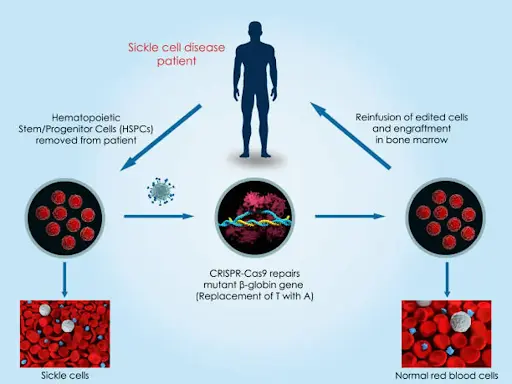
Implications:
- The misshapen red blood cells can block small blood vessels, impairing blood flow and causing chronic anaemia.
- Individuals with SCD often suffer acute pain episodes, severe bacterial infections, and tissue damage due to insufficient blood supply.
Treatment:
- Current treatment options include medications for pain relief and regular blood transfusions to replace damaged red blood cells.
- In rare cases, a bone marrow or stem cell transplant, which carries significant risks, may be recommended.
Eliminating Sickle Cell Disease:
- Recent advancements include the U.S. Food and Drug Administration's approval of CRISPR-Cas9 technology for cell-based gene therapy to treat sickle cell disease in December 2023.
- India faces the primary challenge of developing cost-effective therapy as part of its mission to eradicate sickle cell disease by 2047, initiated by the Prime Minister in July 2023.
- The mission targets conducting over 7 crore screenings among vulnerable tribal populations across 17 States and Union Territories, with three crore screenings completed to date.
CRISPR-Cas9 Gene Editing:
- CRISPR-Cas9, short for Clustered Regularly Interspaced Short Palindromic Repeats and CRISPR-associated protein 9, is a powerful technology enabling geneticists and researchers to edit sections of the genome by modifying DNA sequences.
- Emmanuelle Charpentier and Jennifer Doudna's pioneering work on CRISPR-Cas9, likened to a 'molecular scissor,' earned them the 2020 Nobel Prize in chemistry.
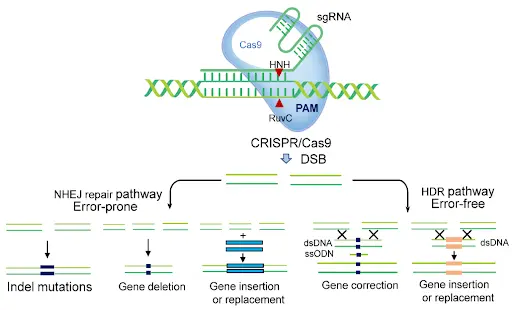
The system comprises two primary components:
- Cas9: This enzyme functions as molecular scissors, cutting the DNA strand at a precise location targeted for modification, such as removal, addition, or alteration of DNA.
- Guide RNA (gRNA): This RNA segment is designed to bind to a specific DNA sequence complementary to its code. The gRNA directs the Cas9 enzyme to the exact location in the genome where genetic editing is intended.
Mechanism:
- Initially, a gRNA is designed to match the DNA sequence requiring modification.
- Once inside the cell, the Cas9 enzyme and gRNA form a complex that locates and binds to the targeted DNA sequence.
- Cas9 then cleaves the DNA at the predetermined site.
- Following the DNA cut, the cell's natural repair mechanisms can be utilised to insert or delete genetic material, or to make precise alterations to the DNA sequence
|
UPSC Civil Services Examination PYQ Prelims: Q:1 Consider the following statements in the context interventions being undertaken under Anaemin Mukt Bharat Strategy :[2023]
How many of the statements given above are correct?
Answer: C |
Source: TH
Persistent Organic Pollutants (POPs)
Why in the news ?
- According to a recent study, Dichloro-diphenyl-trichloroethane (DDT) and 11 other Persistent Organic Pollutants (POPs) have shown a decline in both human exposure and environmental presence since 2004.
- This reduction is attributed to stringent global regulations implemented to control these hazardous substances.
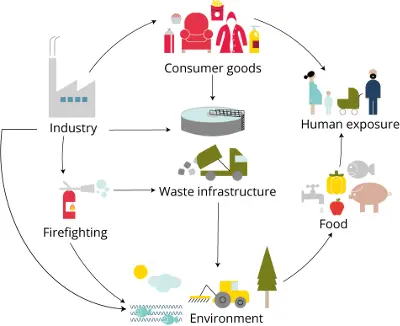
What about Persistent Organic Pollutants (POPs) ?
- Findings from the study indicate that Persistent Organic Pollutants (POPs), including DDT and others, were detected in over 900 samples collected from various sources such as air, water, human milk, soil, and various food items including beef, milk, eggs, and seafood.
- The levels of 12 POPs, including DDT, have shown a global decline since 2004, attributed to stringent regulatory measures.
- However, other POPs like dieldrin and polychlorinated biphenyls (PCBs) continue to persist at elevated levels in the air across regions such as Africa, the Caribbean, and Latin America.
- POPs are carbon-based chemicals that resist degradation through natural processes like chemical reactions, biological breakdown, and sunlight exposure.
Key characteristics of Persistent Organic Pollutants (POPs):
- Persistence: POPs are resistant to environmental breakdown. They can persist for extended periods, ranging from years to decades, without degrading.
- Bioaccumulation: POPs have the tendency to accumulate in the fatty tissues of living organisms through the food chain. This results in higher concentrations of POPs in organisms at the top of the food chain, including humans.
- Long-range transport: POPs can travel long distances from their original source of emission. Global transport occurs through processes such as atmospheric deposition and ocean currents, spreading these pollutants across vast distances.
- Toxicity: Many POPs exhibit toxicity to both humans and wildlife. They can lead to various adverse health effects, including cancer, reproductive disorders, immune system disruption, and neurological impacts.
- POPs include pesticides like DDT (dichloro-diphenyl-trichloroethane), industrial chemicals such as polychlorinated biphenyls (PCBs), and unintentional by-products of industrial processes like dioxins and furans.
- POP pollution include improper use or disposal of agrochemicals and industrial chemicals, high-temperature processes and combustion, and unintentional production during industrial activities or waste incineration.
Regulation of Persistent Organic Pollutants (POPs) :
- Stockholm Convention on POPs: Entered into force in 2004, it aims to globally reduce the release of POPs chemicals.
- Rotterdam Convention on PIC: Also entered into force in 2004, it promotes shared responsibilities in the international trade of hazardous chemicals, ensuring safe use.
- Basel Convention: In force since 1992, it controls transboundary movements and disposal of hazardous wastes to protect human health and the environment.
- LRTAP, Protocol on POPs: The protocol, effective since 2003, aims to limit and reduce air pollution, including long-range transboundary air pollutants like POPs. Its goal is to control, reduce, or eliminate discharges, emissions, and losses of persistent organic pollutants.
Source: DTE
SIPRI Annual Report 2024
Why in the news ?
- Recently, the SIPRI Yearbook 2024 has been published by Oxford University Press on behalf of the Stockholm International Peace Research Institute (SIPRI).
About:
- The SIPRI Yearbook offers comprehensive insights into international security, covering areas such as weapons and technology, military spending, arms production and trade, armed conflicts, conflict resolution efforts, and initiatives aimed at regulating conventional, nuclear, chemical, and biological weapons.
Major Findings from the SIPRI Yearbook 2024:
- Nuclear Arsenal: In 2024, nine states—United States, Russia, United Kingdom, France, China, India, Pakistan, North Korea, and Israel—held approximately 12,121 nuclear weapons. Of these, 9,585 were potentially operational.
- Decline in Nuclear Warheads: Overall, the global number of nuclear warheads is decreasing primarily due to dismantlement efforts by the USA and Russia of retired warheads.
- Operational Warheads: Despite the overall decline, reductions in operational warheads have stalled globally, with numbers beginning to rise again. The USA and Russia, holding nearly 90% of all nuclear weapons, are actively replacing and modernising their arsenals.
- China's Expansion: China is significantly modernising and expanding its nuclear arsenal, tripling its number to around 500 warheads. Some of these warheads are on high operational alert for the first time. Projections indicate China may deploy as many intercontinental ballistic missiles as Russia or the USA soon.
- South Asian Developments: Both India and Pakistan are reportedly increasing their nuclear weapon stockpiles. Additionally, the UK plans to expand its nuclear stockpile.
- North Korea's Program: North Korea's military nuclear program remains integral to its national security strategy, with estimates suggesting it has assembled up to 50 nuclear weapons and has the capability to produce more.
- Israel's Ambiguity: Israel maintains a policy of nuclear ambiguity, leaving uncertainty about the size of its nuclear arsenal.
India's Nuclear Forces :
- Arsenal Size: As of this year, India's nuclear arsenal consists of approximately 172 warheads, slightly exceeding Pakistan's inventory of 170 warheads.
- Triad Strengthening: India is enhancing the undersea component of its nuclear triad, which includes land-based missiles, strategic bombers, and nuclear-powered submarines (SSBNs).
- SSBN Development: India launched its third SSBN (nuclear-powered submarine carrying ballistic missiles armed with nuclear warheads) in 2021. A fourth SSBN is currently under construction, with plans for possible launch by 2024.
|
SIPRI:
|
Challenges in Nuclear Disarmament
- Geopolitical Tensions: Nations often view nuclear weapons as a deterrent against potential adversaries, which hinders willingness to disarm when perceived threats exist.
- Transparency: Verifying compliance with disarmament agreements is challenging, complicating efforts to ensure adherence to agreed-upon reductions.
- Technological Advancements: Advances in nuclear technology, such as smaller and more sophisticated weapons, pose obstacles to effective disarmament initiatives.
- Strategic Stability Concerns: Countries may see nuclear weapons as vital to national security, fearing that disarmament could disrupt strategic stability and deter them from fully committing to disarmament efforts.
- Economic and Strategic Costs: The process of dismantling nuclear weapons and managing their materials is costly and complex, presenting financial and logistical challenges.
- Non-Proliferation Concerns: As some states disarm, others may perceive a strategic advantage in acquiring or retaining nuclear weapons, potentially sparking proliferation concerns and undermining disarmament goals.
Treaties Related to Nuclear Disarmament:
- Treaty on the Non-Proliferation of Nuclear Weapons (NPT):
- Signed in 1968 and effective from 1970, the NPT aims to prevent nuclear weapon proliferation and encourage disarmament.
- It categorises states as nuclear-weapon states (NWS), recognized for possessing nuclear weapons before the treaty, and non-nuclear-weapon states (NNWS), which commit to refraining from nuclear weapons development.
- Treaty on the Prohibition of Nuclear Weapons (TPNW):
- Adopted by the UN in 2017 and open for signature since 2018, the TPNW aims to ban the development, testing, production, stockpiling, stationing, transfer, use, and threat of use of nuclear weapons.
- It marks a significant step towards global nuclear disarmament, although nuclear-armed states have not signed it.
- Comprehensive Nuclear-Test-Ban Treaty (CTBT):
- Opened for signature in 1996, the CTBT seeks to prohibit all nuclear explosions, whether for civilian or military purposes.
- Despite being signed by 185 countries and ratified by 170, its entry into force requires ratification by nuclear-armed states.
- Outer Space Treaty:
- Entered into force in 1967, this agreement prohibits the placement of weapons of mass destruction in space.
- All nine known nuclear-armed states are parties to this treaty, contributing to the prevention of weaponization of outer space.
Source: TH
Eucalyptus Tree
Why in the news ?
- The Kerala government issued an order allowing the Kerala Forest Development Corporation (KFDC) to plant eucalyptus trees for its financial sustenance in 2024-2025.
- As per the 2021 Kerala’s eco-restoration policy, its cultivation (including acacia and wattle) is not suitable for the environment as it results in “depletion of natural forests.”
- Activists alleged that permitting the planting of eucalyptus trees contravened the policy’s aspirations and undermined efforts to beat back invasive species and mitigate human-animal conflicts.
About Eucalyptus tree
- Eucalyptus trees, also known as gum trees, nilgiri trees, or safeda, are species of large flowering trees and shrubs with aromatic leaves and attractive smooth peeling bark.
- These trees are native to Australia and Tasmania. In India, it was first planted around 1790 by the ruler of Mysore, Tipu Sultan, in his palace garden near Bangalore.
Uses of eucalyptus trees
- Eucalyptus wood is hard and difficult to bend, making it ideal for flat furniture.
- Since the wood is heavy, it is, therefore, good as firewood and for making charcoal.
Criticism of Eucalyptus
- The ban on eucalyptus has emerged as part of the campaign against invasive species.
- Eucalyptus is water-intensive and reduces available water for other species by effectively out-competing them.
- In arid areas, it consequently suppresses different plant life, coupled with high water demand, reduces soil moisture, prevents groundwater recharge, and can reduce local water tables. This is worsened by a high transpiration rate indicative of the inefficient use of water.
- Eucalyptus does not promote the building of humus. It does not contribute to the soil’s long-term fertility resulting in an overall nutrient impoverishment of the soil.
- Eucalyptus is toxic due to its allelopathic properties, which reduce other plant life by restricting germination of other species and is also detrimental to soil micro and macrofauna.
|
Source: (TH)
Markhor (Capra falconeri)
Why in the news ?
- Recently, the UN declared 'IUCN: Near Threatened of Markhor’.

- The Markhor, also known as screw horn goat, is the largest wild goat in the world. It is the national animal of Pakistan.
- Distribution: It ranges over the north-western parts of the Hindu Kush Himalayas, in Uzbekistan, Turkmenistan, Tajikistan, Afghanistan, Pakistan and India.
- In India, the subspecies is found only in Jammu and Kashmir (J&K).
- Habitat: They are adapted to mountainous terrain between 600 m and 3600 m elevation and are strongly associated with scrub forests dominated by oaks, pines, and junipers.
- Physical description: The coat is of light brown to black colour and is smooth and short in summer while growing longer and thicker in winter. Both sexes possess extremely bold, flared, corkscrew-like horns which twist outwards.
- They are skilled climbers and can scale steep rocky terrain to escape predators such as snow leopards and wolves.
- Conservation Status: IUCN: Near Threatened | WPA, 1972: Schedule I | CITES: Appendix I
- Threats: Illegal hunting, poaching, habitat loss, climate change.
Source: (DTE)
Oedocladium sahyadricum (Algae)
Why in the news ?
- Phycologists at Catholicate College, Pathanamthitta, Kerala, found a new algal species. The new species is named Oedocladium sahyadricum. Sahyadricum refers to the Western Ghats.
- Western Ghats provide ideal conditions for the growth of terrestrial microalgae.
|
About Oedocladium sahyadricum
- Features: Dioecious and terrestrial, with a superior operculum, ellipsoid oogonium, and oospore.
- Dioecious: Having the male and female reproductive organs in separate individuals.
- Operculum: It is a cap-like structure in some flowering plants, mosses, and fungi.
- Oogonium: The female sex organ of certain algae and fungi.
- Oospore: It forms when an oogonium (female gamete) is fertilised by a male gamete nucleus.
- Appearance: Found as a thin mat of elongated strands on damp soil, velvety green turning yellowish-green as it matures.
- Climatic conditions: Abundant growth likely needs rainy weather.
- Potential Applications: Potential uses in medicine, agriculture, and the production of astaxanthin, a natural pigment with health benefits.
- Economic Importance: Algae are used in high-value products & wastewater treatment.
Source: (TH)
An Ageing Population of India
Conext:
- The ageing phenomenon stands out as a defining experience of the 21st century, characterised by significant improvements in human longevity alongside historically low reproduction rates.

About the Ageing Population in India:
- Projected Growth of Elderly Population
- Current Population: India’s elderly population, currently at 153 million (aged 60 and above), is expected to nearly double, reaching 347 million by 2050.
- India Ageing Report 2023
- Percentage Growth: The elderly population is projected to grow from 10.5% of the total population in 2022 to 20.8% by 2050.
- Population Increase: The number of individuals aged 60 and above is anticipated to rise from 14.9 crore to an estimated 34.7 crore.
- Age Structure Reversal
- By 2046, the elderly population is expected to surpass the number of children (aged 0 to 15 years), indicating a shift from a historically young populace to an ageing demographic.
- National Commission on Population Report (2020)
- Growth Rate and Projections: The elderly population is currently growing at an estimated decadal rate of 41% and is projected to constitute over 20% of the total population by 2050.
- Comprehensive Review:
- Data Sources: The report draws on data from the Longitudinal Ageing Survey in India (LASI), Census of India, and Population Projections by the Government of India.
- Growth Rate: The elderly population is currently growing at an estimated rate of 41% per decade, with projections showing it will double to 20.8% of the total population by 2050.
- Sex Ratio Among Elderly
- Trend: The sex ratio (females per 1,000 males) among the elderly has been steadily increasing since 1991, unlike the stagnating ratio in the general population.
- Census 2011 Data: India has 104 million older people (60+ years), making up 8.6% of the total population, with females outnumbering males in this age group.
|
Who Qualifies as Elderly?
Categories:
World Population Data Sheet (2002): Age Group: 65+ years. Classification: Aged Population Indian Context:
|
Demographics of the Elderly:
- Gender Ratio: Predominantly female with 1,065 females per thousand males.
- Widowhood: 54% of elderly women will be widows.
- Living Alone: 6% of elderly men and 9% of elderly women live alone.
- Rural Elderly: 70% residing in rural areas.
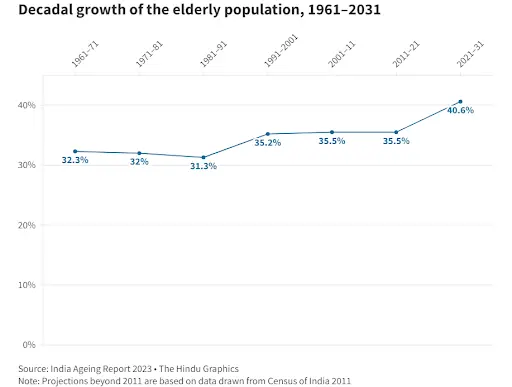
Primary Factors Contributing to the Ageing Phenomenon in India:
- Increased Longevity
- Healthcare Advancements: Significant improvements in healthcare services, medical technology, treatments, and preventive care.
- Life Expectancy: WHO reports an increase in life expectancy from 62.1 years in 2000 to 67.3 years in 2021.
- Improved Living Conditions
- Better Living Standards: Access to clean water, sanitation, and improved nutrition.
- Sanitation Coverage: The Swachh Bharat Abhiyan has reduced waterborne diseases through increased sanitation coverage.
- Decreased Fertility Rates
- Family Planning: Successful implementation of family planning programs.
- Total Fertility Rate: According to NFHS 2019-21, TFR has declined to 2.0 children per woman, below the replacement level of 2.1.
- Socio-Economic Changes
- Female Education and Workforce Participation: Higher education and workforce participation among women lead to delayed marriages and fewer children.
- Urbanisation: Smaller family norms due to the higher cost and demands of raising children in urban areas.
- Kerala Model: High literacy rates and advanced healthcare contribute to high life expectancy and low fertility rates, serving as a model for managing the ageing population.
The Various Challenges Associated with Elderly Population in India:
- Restrictions in Activities of Daily Living (ADL)
- Prevalence of Restrictions: Approximately 20% of the elderly face limitations in activities like bathing, dressing, eating, and mobility.
- Impact of Support Systems: Elders living alone or lacking family support often struggle with ADLs, increasing their dependence on caregiving services.
- Multi-Morbidity
- Chronic Conditions: About 75% of the elderly in India suffer from multiple chronic diseases such as hypertension, diabetes, arthritis, and cardiovascular issues.
- Impact on Quality of Life: Coexistence of these conditions reduces quality of life and escalates healthcare requirements.
- Poverty
- Economic Vulnerability: More than 40% of India's elderly belong to the poorest wealth quintile, with about 18.7% having no income.
- Quality of Life Impact: Economic instability affects their healthcare access and overall well-being significantly.
- Changing Healthcare Needs
- Demographic Challenge: With elder population growth outpacing younger generations, meeting diverse healthcare needs becomes crucial.
- Specialised Services: Elderly require specialised medical services like telemedicine, physiotherapy, mental health counselling, and pharmaceutical support at home.
- Social Issues:
- Neglect and Stigma: Factors like familial neglect, low education, socio-cultural beliefs, and distrust in institutional healthcare worsen conditions for elders.
- Access Inequity: Inequitable access to facilities compounds challenges, limiting physical, financial, and psychological support for the elderly.
- ‘Inherently Gendered’:
- Feminization of Ageing: A higher proportion of elderly women compared to men face challenges like widowhood, economic dependency, and limited assets.
- Sex Ratio Trends: The sex ratio among the elderly has varied, showing higher ratios in earlier decades but stabilising around 1033 females per 1000 males in 2011.
- Inadequate Welfare Schemes:
- Healthcare Coverage Gaps: Despite schemes like Ayushman Bharat, 400 million Indians lack financial health coverage.
- Pension Challenges: State and central pension schemes offer minimal support, with some providing as little as ₹350-₹400 monthly, which isn't universally accessible.
Steps Should be Taken to Empower the Elderly Population in India:
- Protection from Destitution
- Besides pensions, access to healthcare, disability aids, assistance with daily tasks, recreational opportunities, and social engagement are crucial for their well-being.
- Emulating the Frontrunners
- States like Odisha and Rajasthan have achieved near-universal social security pensions, setting examples for others.
- Revamping the National Social Assistance Programme (NSAP) nationwide would streamline pension distribution and benefit all states uniformly.
- Recognising
- Policies must address the needs of elderly women, particularly widows. Focus should be on supporting vulnerable older women to live independently and respectfully.
- Welfare & Bills:
- Senior Citizens (Amendment) Bill, 2019, Bill aims to regulate and set standards for home-based elder care services, yet awaits parliamentary approval since its introduction in 2019.
- Building Elderly Inclusive Society
- Promoting community integration ensures elderly remain active contributors rather than isolated in facilities. Leveraging their skills and experience benefits society, fostering their active participation in community life.
- Transforming the Perception of the Elderly
- Innovative programs like U3A offer continuous learning opportunities, empowering elderly with knowledge and skills.
- Schemes like Singapore's Senior Employment Scheme match elderly job seekers with employers, recognizing their reliability and experience.
|
Initiatives Taken by Indian Government:
|
Conclusion:
Innovative institutions and social agencies are pivotal in reshaping the elderly's perception from burdens to valuable assets. Through initiatives promoting education, employment, volunteering, health, wellness, and social inclusion, policies must empower the elderly and integrate them into active societal roles.
|
UPSC Civil Services Examination Previous Year Question Prelims: Q:1 Consider the following statements with reference to Indira Gandhi National Old Age Pension Scheme (IGNOAPS): (2008)
Which of the statements given above is/are correct?
Ans: D Mains: Q:1 Performance of welfare schemes that are implemented for vulnerable sections is not so effective due to the absence of their awareness and active involvement at all stages of the policy process. Discuss. (2019) |
Source:TH
Share the article
Edukemy’s Current Affairs Quiz is published with multiple choice questions for UPSC exams
MCQ
Get Latest Updates on Offers, Event dates, and free Mentorship sessions.

Get in touch with our Expert Academic Counsellors 👋
FAQs
UPSC Daily Current Affairs focuses on learning current events on a daily basis. An aspirant needs to study regular and updated information about current events, news, and relevant topics that are important for UPSC aspirants. It covers national and international affairs, government policies, socio-economic issues, science and technology advancements, and more.
UPSC Daily Current Affairs provides aspirants with a concise and comprehensive overview of the latest happenings and developments across various fields. It helps aspirants stay updated with current affairs and provides them with valuable insights and analysis, which are essential for answering questions in the UPSC examinations. It enhances their knowledge, analytical skills, and ability to connect current affairs with the UPSC syllabus.
UPSC Daily Current Affairs covers a wide range of topics, including politics, economics, science and technology, environment, social issues, governance, international relations, and more. It offers news summaries, in-depth analyses, editorials, opinion pieces, and relevant study materials. It also provides practice questions and quizzes to help aspirants test their understanding of current affairs.
Edukemy's UPSC Daily Current Affairs can be accessed through:
- UPSC Daily Current Affairs can be accessed through Current Affairs tab at the top of the Main Page of Edukemy.
- Edukemy Mobile app: The Daily Current Affairs can also be access through Edukemy Mobile App.
- Social media: Follow Edukemy’s official social media accounts or pages that provide UPSC Daily Current Affairs updates, including Facebook, Twitter, or Telegram channels.

